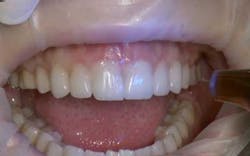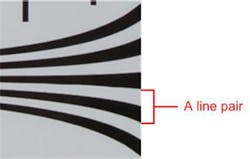Line pairs in digital sensors: what are they, what do they mean, and what do I need to know about them?
By James Ramey, Director of Digital Imaging, Dentimax LLCLine pair is a term that dental sales representatives throw around when they are trying to sell digital sensors. The sales rep will also usually wait to hear what other brands of sensors interest you before throwing this word out. The reason they do this is that the competition they are going up against may have a better number in this statistic than their sensor does! That’s all it really is — another statistic such as resolution, pixels, active area, and so on. But we are here to discuss the statistic of line pairs. This brings me to the initial question: What is a line pair?A line pair is, simply, the result of a test that manufacturers perform to determine a couple of different things: 1) Whether the specific sensor they are looking at meets or exceeds the standard they have set for their product, and 2) what is the number of line pairs they can publish as their statistic. To do this they use what is called a line pair tester.A line pair tester is a piece of film (also referred to as a target) that has markings on it (made out of lead) for every millimeter. In the first millimeter, there is one lead line present. If you take an X-ray of the line pair film and you can clearly see the line, then the sensor successfully has one line pair per millimeter. More lines are added with every millimeter, so the next section will have two lines within the millimeter, then three, four, five, and so on. Most of the line pair testers stop at 20 line pairs per millimeter; but with newer and better sensors, the manufacturers of these test devices have increased the number of line pairs to 25 or even 30.When the test is performed, the tester takes an X-ray of the line pair film and then looks at it. Viewing the X-ray of the test device, the tester looks up the scale from one millimeter to five to 10 and so on, and then tries to see how many individual lines can be clearly seen before they start to blend together and look like a solid block or a bunch of lines that are touching each other (the lines should not touch each other in a true line pair test). This fact alone makes the test somewhat subjective.
To get the statistic for a sensor, the test is performed many times until a statistical average can be calculated on how many line pairs the sensor has. It is really as simple as that.Now here is where the sales tactic comes into play. There are two types of statistics for line pairs: actual and theoretical.An actual line pair test is what you can see with your naked eye. This is the number that you, as a dentist, should be interested in. However, this is not always the statistic that is published. The company may publish the theoretical line pair number. Moreover, if you flat out ask the sales rep which of the two he or she is giving you, more often than not the rep will not know enough about the subject to give you an honest answer. Depending on the person of course, he or she will more than likely tell you that it is the actual number.The theoretical number is found using many complex statistical calculations based on the test data that is returned from the testing in the laboratory. When I say “complex,” you definitely need a math degree to even understand how they arrive at that number.What all of this boils down to is that it doesn’t really mean much to you as a dentist no matter how many line pairs a company claims its sensors produce. When making your decision on what sensor you want, the factors to consider for image quality are in the image itself. What can you SEE? All the statistics in the world cannot take the place of the dentist’s best tools: his or her own mind and eyes.
James W. Ramey has a Bachelor of Science degree in management information systems from the University of Akron. For the last eight years, Mr. Ramey has worked exclusively with digital radiography technology and has experience with most sensors on the market, including digital, panoramic, cephlometric, and intraoral cameras. You may contact him at [email protected].



